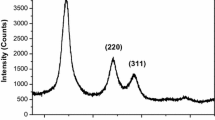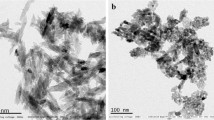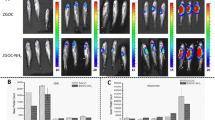Abstract
When incubated with nanomolar concentrations of fluorescent semiconductor nanocrystals in moderately hard water the fluorescence of living Ceriodaphnia dubia increased. Average pixel intensity of exposed animals was greater than that of unexposed animals and increased in a dose and exposure time-dependent-manner. Internal structures were clearly visible in exposed and unexposed animals but fluorescence was most intense in the region of the abdominal appendages of exposed animals. Since these nanoparticles contain significant quantities of the toxic metals cadmium and selenium, their accumulation from aquatic environments by this standard test organism has significant implications about their potential environmental toxicity.
Similar content being viewed by others
Explore related subjects
Discover the latest articles, news and stories from top researchers in related subjects.Avoid common mistakes on your manuscript.
Engineered nanomaterials that differ in size, shape, surface area and chemical composition are currently used in research applications, and, on a larger scale, in industrial and consumer applications. Concerns for environmental effects accompanying the increased use of nanoparticles are commonly addressed (Colvin 2003; Sharpe 2003; Mulhall 2004). Although carbon-nanostructures have received some toxicological characterization (Colvin 2003; Oberdörster 2004; Lavern and Klaper 2006; Roberts et al. 2007) few results pertinent to the toxicology of other nanoscale particles have been reported. Of particular relevance to this study, at present nothing is known about where QDs partition in the environment and very little is known about routes of exposure (Hardman 2006). There have been several in vitro studies that suggest that QDs have significant toxicity to cultured cells (e.g. Lovric et al. 2005; Hoshino et al. 2004), while others have reported no toxic effects after in vitro (Voure et al. 2004; Jaiswal et al. 2003; Chen and Gerion 2004) or in vivo (Larson et al. 2003; Ballou et al. 2004) exposures.
Semiconductor nanocrystals can be engineered to fluoresce at visible wavelengths and are commercially available from a number of sources. They have the distinct advantage over other available fluorophores of providing long-lasting stable fluorescence that is extremely fade resistant. Because of these advantages and the ease with which the surface of the nanoparticle can be modified, these nanoparticles are finding wide spread use as in vivo and in vitro markers, labels and trackers (Pellegrino et al. 2003). Typically, semiconductor nanocrystals (QDs) contain a Cd/Se or Cd/Te crystalline core (diameter ∼4 nm) that is coated with a shell of ZnS. This shell is covered with an organic polymer (e.g. polyethylene glycol) that can be treated so that active residues are available for linking to other molecules (e.g. antibodies, lectins and nucleic acids). The overall diameter of the resulting nanoparticle is ∼10–25 nm or about the size of a small proteins. Some investigators have reported that the surface coatings of QDs are subject to photolysis or oxidation (Derfus 2004; Aldena et al. 2001; Kloepfer et al. 2003). This may result in the core dissolving so that the toxic metals it contains are available as hydrated ions. The results of one in vitro study suggest that this significantly increases the toxicity associated with QD exposure in cultures of primary rat hepatocytes (Derfus 2004). Very little is known about the uptake of QDs by aquatic organisms. However, because of the known toxicity of metals used in microcrystal nanoparticles, the potential effects of introducing these nanomaterials into the environment warrant thorough investigation. In this investigation the fluorescence properties of commercially available QDs were used to detect absorption of QDs by an aquatic test organism, Ceriodaphnia dubia, by using standard microscopy techniques to measure changes in fluorescence intensity of animals exposed to QDs.
Materials and Methods
Ceriodaphnia dubia were grown in accordance with USA EPA (2002) protocol at the Arkansas State University Ecotoxicology Research Facility. Moderately hard water (MHW, hardness = 90 mg/L as CaCO3, pH 7.2) was used for daphnia maintenance and QD suspensions. Adult animals (age 5–14 days) were exposed to ambient light and a temperature of ∼22°C was maintained. Animals were fed daily (1.5 mL per 100 mL water per 15 animals) with a combination of laboratory produced algae and yeast-cereal leaves-trout chow diet (YCT) for C. dubia (USA EPA 2002).
Qdot® 545 ITK™ Carboxyl Quantum Dots (Fisher Scientific, USA; Fisher part no Q21391MP) were used in all experiments. The peak emission of these particles is between 541 and 549 nm. The organic polymer coating of these nanoparticles was treated so carboxyl groups were available on their surface. The manufacturer specified that QD concentration in purchased suspensions was 7.7 μm.
Adult animals were exposed to QDs by incubating 12 animals in 100 mL of MHW containing 0 (control), 200, 400 or 600 ppt QDs. Exposure suspensions were made by diluting purchased QD suspensions with MHW. For each trial three replicates of each concentration were prepared so that different animals could be sampled after a 4, 8 or 24 h exposure. Eight animals were removed at random from each exposure vessel for examination after each incubation period (4, 8 or 24 h). This process was repeated six times so that a total of six different groups were examined at each time and exposure dose. All replicates included unexposed groups (54 groups total). No animal mortality was observed during the exposures.
Immediately after removal from incubation suspension live animals were placed on a glass slide in a small droplet of MHW. All images were taken of living animals using a Nikon epifluorescence microscope (Nikon Eclipse E800, excitation λ 465–495: emission λ 515–555 nm) equipped with a mercury-vapor illumination and a Cascade Photometric digital camera. A brightfield image of each animal was taken. To insure consistent focus, the post abdominal claw was in clear focus in each of these images. A fluorescent image was then taken without altering the focus (for example, see Fig. 1). Images were digitized using Nikon ACT-1© software and stored for further analysis. All animals were imaged within 60 s of removal from incubation suspensions.
Images of unexposed daphnid. Brightfield (left and center panels) and fluorescent (right panel) images of a daphnid exposed to 200 nm QDs for 8 h. The abdominal hook that was used as a focus reference is circled in the leftmost panel. The black outline shown in the middle panel was produced by tracing the outline of the daphnid in the digital brightfield image. Because the edges of the daphnia were not always visible in fluorescence images, this outline was copied to the fluorescence image of the same daphnid. The number and average intensity of the pixels within the outline was measured. Notice that brightness within the fluorescence image is not uniformly distributed. For example, comparison of fluorescence image in Fig. 1 to that in Fig. 2 shows a slight increase in the brightness of the digestive tract, but the greatest increase is in the region of the thoracic appendages
MetaMorph© 6.10 Meta Imaging Series Environment (Universal Imaging Corporation™) was used to measure average pixel intensity in the fluorescence image of each animal. The outline of each animal (not including the dorsal brood pouch) was traced on the brightfield image of that animal. This outline was transferred to the fluorescence image of that animal (illustrated in Fig. 2). The number and average intensity of the pixels within the outline on the fluorescence image was measured. The number of pixels in each outline was used to verify that the size of the organisms was not affected by exposure dose or time.
Images of an unexposed daphnid. Brightfield (left panel) image includes outline that has been transferred to the fluorescence (right panel) image of the same organism. Fluorescence image shows slight autofluorescence of the digestive tract and heart. Comparison of this fluorescence image to that in Fig. 1 shows the much greater intensity associated with exposure to these QDs
Measurements of the number of pixels and average pixel intensity of all animals in each replicate of unexposed (control) animals and exposed animals were compared using a repeated measures ANOVA with Prism© 4.0 (GraphPad Software, San Diego, CA, USA) at each time interval. Because this comparison showed that there was no difference in average size or pixel intensity of unexposed replicates sampled at each time point, all unexposed replicates were grouped for comparisons to exposed animals.
Results and Discussion
Size of all animals was estimated by counting the number of pixels in each image. Comparison of size of animals after different exposure times and after exposure to different concentrations of Q-dots showed that there was no significant difference in animal size. Average size of images of exposed animals was 5,164 ± 648 pixels while average size of unexposed animals was 5,172 ± 669 pixels. Thus, changes in fluorescence intensity were not related to animals’ growth patterns.
Untreated animals exhibited slight autofluorescence. This was most evident in the digestive tract and was not influenced by incubation time (p > 0.05, see Fig. 2). Treated animals showed significant increases in fluorescence (compare fluorescence images in Figs. 1 and 2). At all exposure concentrations there were significant increases in fluorescence within 4–8 h of exposure. Twenty-four hours after exposure began there was no significant difference in fluorescence intensity of animals exposed to different QD concentrations (Fig. 3). Internal structures were clearly visible and differentially labeled in exposed animals. For example, the digestive tract of exposed animals was brighter than that of unexposed animals, but the greatest increase in brightness was in the region of the thoracic appendages (compare fluorescence image in Fig. 1 to that in Fig. 2). The techniques used in this investigation did not allow the concentration of quantum dots associated with exposed daphnia to be measured. In fact, using these techniques, there was no fluorescence in the concentrations of QD suspensions either prior to or following daphnia exposure. Therefore, results indicate that these aquatic organisms absorb and concentrate QDs against appreciable concentration gradients. QD accumulations in this study are similar to previous studies with lipid-coated carbon nanotubes. Following ingestion by Daphnia magna, Roberts et al. (2007) reported visible accumulation of water soluble carbon nanotubes filling the gut track of exposed organisms.
Average pixel intensity in fluorescence (excitation λ 465–495; emission λ 515–555 nm) images of C. dubia exposed to various concentrations of QDs. All values are average pixel intensity of exposed animals (6 groups at each dose and time). Unexposed data are average of all unexposed groups (n = 54). Error bars are ±SEM. Statistical comparisons made using repeated measures ANOVA of the average pixel intensity of animals in each replicate. (a) Significantly different from unexposed animals (p < 0.01). (b) Pixel intensity of animals exposed to 200 ppt QDs for 4 h was significantly different than that of animals exposed for 4 h to 400 (p < 0.05) or 600 ppt (p < 0.01). (c) Pixel intensity of animals exposed for 200 ppt QDs for 8 h was significantly different than that of animals exposed to 400 ppt for 8 h (p < 0.01). There were no significant exposure concentration-dependent differences after 24 h
QDs used in these experiments contain significant amounts of potentially toxic metals Cd and Se. Since toxicological endpoints of Cd (CdCl2 LC 50) from 54–59 μg/L using C. dubia as a test organism have been reported (Bitton et al. 1996; Diamond et al. 1997; Lee et al. 1997), this provides strong motivation for further efforts to measure the toxic effects of these QDs in aquatic environments. These preliminary results also suggest that acute exposures to intact quantum dots have little toxic effects on C. dubia. This may be because the Cd/Se nanocrystal is encapsulated in nontoxic materials that prevent exposure of test organisms to these metals. Further studies are needed to evaluate the effect of environmental factors on the integrity of these coatings, on effects of chronic exposures to quantum dots and on the environmental fate of the metals contained in the nanocrystal core of such particles.
References
Aldena J, Wang YA, Peng X (2001) Photochemical instability of CdSe nanocrystals coated by hydrophobic thyols. J Am Chem Soc 123:8844–8850. doi:10.1021/ja016424q
Ballou B, Langerholm BC, Ernst LA, Bruchez MP, Waggoner AS (2004) Noninvasive imaging of quantum dots in mice. Bioconjug Chem 15(1):79–86. doi:10.1021/bc034153y
Bitton G, Rhodes K, Koopman B (1996) Ceriofast™; an acute toxicity test based on Ceriodaphnia dubia feeding behavior. Environ Toxicol Chem 15(2):123–125. doi:10.1897/1551-5028(1996)015<0123:SCCAAT>2.3.CO;2
Chen FQ, Gerion D (2004) Fluorescent CdSe/ZnS nanocrystal peptide conjugates for long-term, nontoxic imaging and nuclear targeting in living cells. Nano Lett 4:1827–1832. doi:10.1021/nl049170q
Colvin VL (2003) The potential environmental impact of engineered nanomaterials. Nature Biotechnol 21(10):1166–1170. doi:10.1038/nbt875
Derfus A (2004) Probing the cytotoxicity of semiconductor quantum dots. Nano Lett 4:11–18. doi:10.1021/nl0347334
Diamond JM, Koplish DE, McMahon J III, Rost R (1997) Evaluation of the water-effect ratio procedure for metals in a riverene system. Environ Toxicol Chem 16(3):509–520. doi:10.1897/1551-5028(1997)016<0509:EOTWER>2.3.CO;2
Hardman R (2006) Toxicologic review of quantum dots: toxicity depends on physiochemical and environmental factors. Environ Health Perspect 114(2):165–172
Hoshino A, Kouki F, Oku T, Suga M, Sasaki YF, Ohta M, Yasuhara M, Suzuki K, Yamamoto K (2004). Physiochemical properties and cellular toxicity of nanocrystal quantum dots depend on their surface modification. Nano Lett 4(11):2163–2169. doi:10.1021/nl048715d
Jaiswal JK, Mattousai H, Mauro JM, Simon SM (2003) Long-term multiple color imaging of live cells using quantum dot bioconjugates. Nature Biotechnol 21:47–51. doi:10.1038/nbt767
Kloepfer JA, Mielke RE, Wong MS, Nealson KH, Stucky G, Nadeau JL (2003) Quantum dots as strain- and metabolism-specific microbiological labels. Appl Environ Microbiol 69(7):4205–4213. doi:10.1128/AEM.69.7.4205-4213.2003
Larson Dr, Zipfel WR, Williams RM, Clark SW, Bruchez MP, Wise FW, Webb W (2003) Water soluble quantum dots for multiphoton fluorescence imaging in vivo. Science 300(5624):1434–1436. doi:10.1126/science.1083780
Lavern SB, Klaper RA (2006) Daphnia magna mortality when exposed to titanium dioxide and fullerene (C60) nanoparticles. Environ Toxicol Chem 25(4):1132–1137. doi:10.1897/05-278R.1
Lee S III, Na EJ, Cho YO, Koopman B, Bitton G (1997) Short-term toxicity test based on algal uptake by Ceriodaphnia dubia. Water Environ Res 69(7):1207–1210. doi:10.2175/106143097X125957
Lovric J, Bazzi HS, Cuie Y, Fortin GRA, Winnik FM, Maysinger D (2005) Differences in subcellular distribution and toxicity of green and red emitting CdTe quantum dots. J Mol Med 83(5):377–385. doi:10.1007/s00109-004-0629-x
Mulhall D (2004) Reassessing risk assessment. Futurist 38(1):36–42
Oberdörster E (2004) Manufactured nanomaterials (Fullerenes, C60) induce oxidative stress in the brain of juvenile largemouth bass. Environ Health Perspect 112(10):1058–1062
Pellegrino T, Parak WJ, Boudreau R, LeGros MA, Gerion D, Alivisatos AP, Larabell CA (2003) Quantum dot-based cell motility assay. Differentiation 71:542–548. doi:10.1111/j.1432-0436.2003.07109006.x
Roberts AP, Mount AS, Seda B, Souther J, Qiao R, Lin S, Ke PC, Rao AM, Klaine SJ (2007) In vivo Biomagnification of lipid-coated carbon nanotubes by Daphnia magna. Environ Sci Technol 41:3025–3029. doi:10.1021/es062572a
Sharpe M (2003) It’s a bug’s life: biosensors for environmental monitoring. J Environ Monit 5:109–113. doi:10.1039/b314067a
USA EPA (2002) Methods for measuring the acute toxicity of effluents and receiving waters to freshwater and marine organisms. 4th edn. United States Environmental Protection Agency, National Center for Environmental Publications (NSCEP), Cincinnati, OH EPA 821/R-02/012
Voure EB, Jaiswal JK, Mattoussi H, Simon SM (2004) Tracking metastatic tumor cell extravasation with quantum dot nanocrystals and fluorescence emission-scanning microcopy. Nat Med 10:993–998. doi:10.1038/nm1096
Acknowledgements
Research funded by Arkansas BioSciences Institute, the McNair Research Program at ASU (Taylor Ingle and Regina Alexander) and the NIH (Grant P20 RR-16460 from the INBRE Program of the NCRR to R Buchanan).
Author information
Authors and Affiliations
Corresponding author
Rights and permissions
About this article
Cite this article
Ingle, T.M., Alexander, R., Bouldin, J. et al. Absorption of Semiconductor Nanocrystals by the Aquatic Invertebrate Ceriodaphnia dubia . Bull Environ Contam Toxicol 81, 249–252 (2008). https://doi.org/10.1007/s00128-008-9481-y
Received:
Accepted:
Published:
Issue Date:
DOI: https://doi.org/10.1007/s00128-008-9481-y







